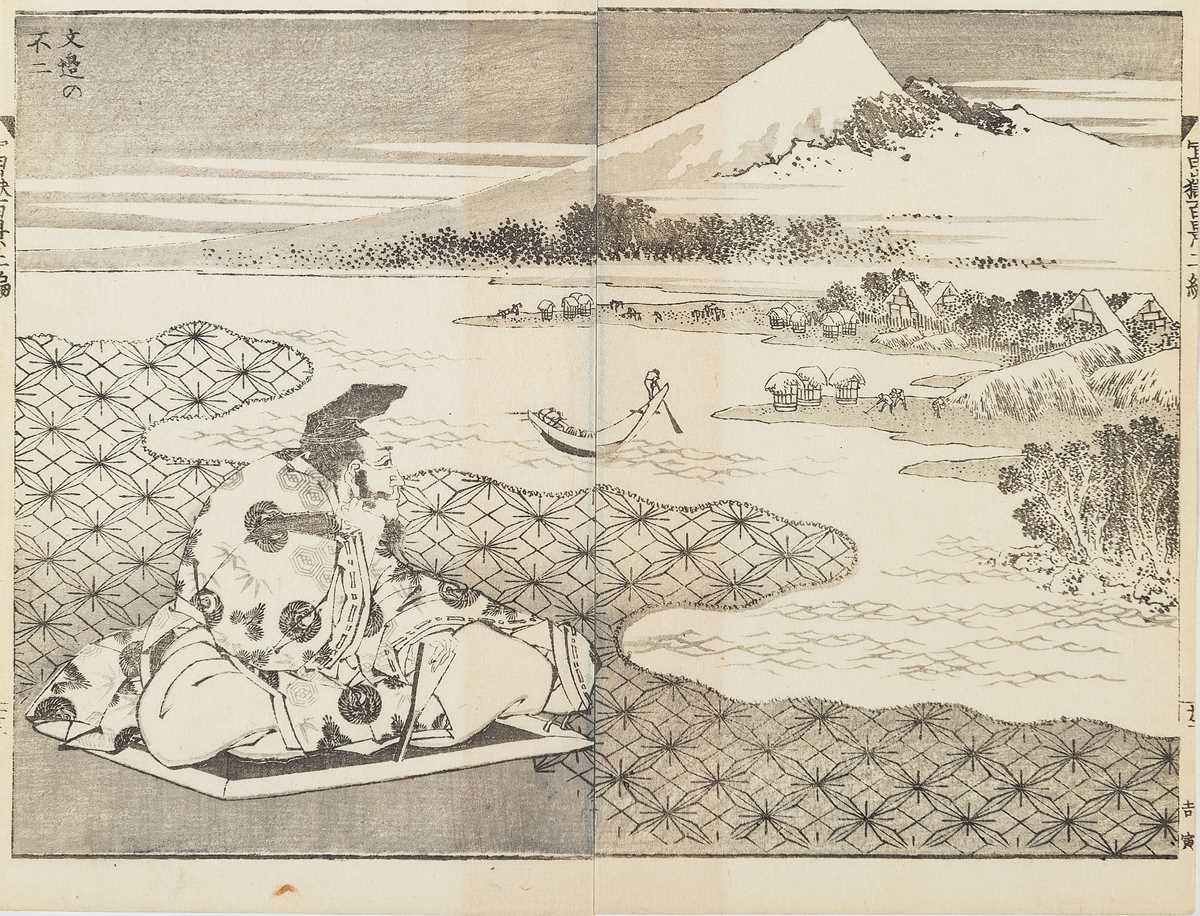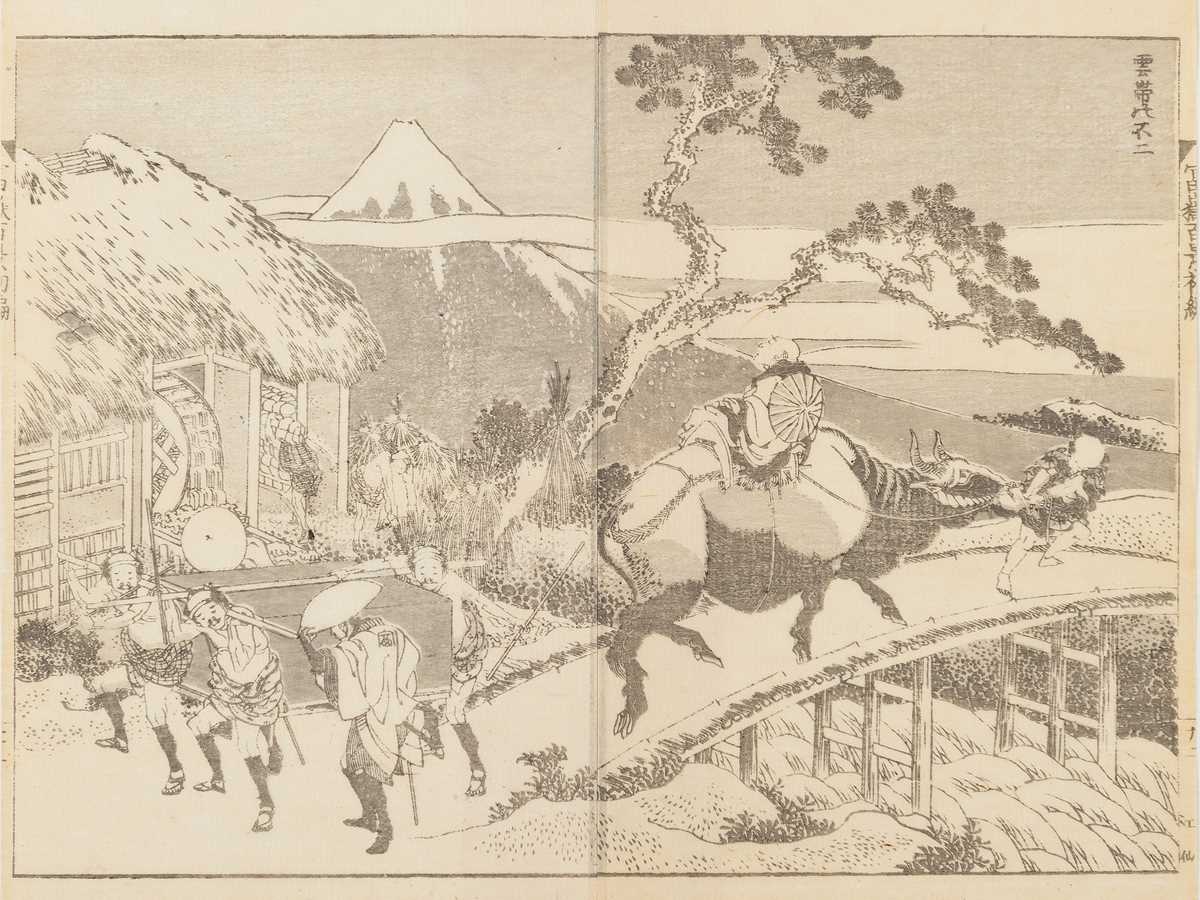DescriptionKatsushika Hokusai (1760-1849)The Poet Abe no Nakamaro Edo period, 19th century
woodblock print, from the series One Hundred Poems, Explained by the Nurse (Hyakunin isshu uba ga etoki), signed Saki no Hokusai Manji (Manji, the former Hokusai), censor's seal kiwame (approved), published by Iseya Sanjiro (Eijudo), circa 1835–36
Horizontal oban: 25.2 x 37.5 cm., 9⅞ x 14¾ in.Condition reportVery good impression and good colour, good condition overall, slight trimming to right-hand edge and minor creasing, small traces of mounting tape to the reverse corners.
The lot is sold in the condition it is in at the time of sale. The condition report is provided to assist you with assessing the condition of the lot and is for guidance only. Any reference to condition in the condition report for the lot does not amount to a full description of condition. The images of the lot form part of the condition report for the lot. Certain images of the lot provided online may not accurately reflect the actual condition of the lot. In particular, the online images may represent colors and shades which are different to the lot's actual color and shades. The condition report for the lot may make reference to particular imperfections of the lot but you should note that the lot may have other faults not expressly referred to in the condition report for the lot or shown in the online images of the lot. The condition report may not refer to all faults, restoration, alteration or adaptation. The condition report is a statement of opinion only. For that reason, the condition report is not an alternative to taking your own professional advice regarding the condition of the lot. NOTWITHSTANDING THIS ONLINE CONDITION REPORT OR ANY DISCUSSIONS CONCERNING A LOT, ALL LOTS ARE OFFERED AND SOLD "AS IS" IN ACCORDANCE WITH THE CONDITIONS OF SALE/BUSINESS APPLICABLE TO THE RESPECTIVE SALE.LiteratureNagata, Hokusai Museum (Hokusai Bijutsukan): Tales (Monogatari-e), vol. 5, 2nd ed. (Tokyo, 1990), pl. 135.
W. Crothers, T. Kobayashi and J. Berndt, Hokusai, exh. cat. (Melbourne, 2017).ExhibitedNational Gallery of Victoria (NGV) International, Melbourne, Hokusai, 21st July - 15th October 2017. Catalogue noteOne Hundred Poems Explained by the Nurse (Hyakunin isshu uba ga etoki) was Hokusai's final series of single-sheet woodblock prints. He based it upon a thirteenth century anthology of well-known poems, the Hyakunin Isshu (A Hundred Poems by a Hundred Poets). These poems, based on love and melancholy, were assembled by the poet Fujiawara no Teika. Hokusai chose to visually recount the poems from the perspective of a fictional elderly nurse. The series was never completed and only twenty-seven published prints are known. However, other unpublished designs exist for a further sixty-two prints, all preparatory drawings and one key-block print. The series was commissioned by the publisher Nishimura Yohachi and his firm Eijudo successfully issued five prints before closing down; the additional twenty-two prints were then published by Iseya Sanjiro’s firm Iseri, with the original Eijudo seal continuing to be employed. The poem in this print is by Abe no Nakamaro (710-790), who travelled to China as a youth to discover the secrets of the Chinese calendar. On discovering his intentions, the Emperor of China had him arrested; the scene depicted by Hokusai in this print. The poem by Abe no Nakamaro has been translated by Peter MacMillan in One Hundred Poets, One Poem Each: A Treasury of Classical Japanese Verse, (London, 2016), p. 10: I gaze up at the sky and wonder:is that the same moonthat shone over Mount Mikasa at Kasuga all those years ago?
Ama no harafurisake mirebaKasuga naruMikasa no yama niideshi tsuki kamo Abe no Nakamaro stands on a hilltop at the centre of the composition. Clothed in an elegant robe, he is flanked by two kneeling soldiers and further soldiers a little further back, who wait respectfully for him to finish his verse. The poet longingly looks out towards his homeland, the moon - the central subject of the poem - is abstractly included by Hokusai as a reflection in the water. For a similar impression in the collection of The Museum of Fine Arts, Boston, accession no. 11.17664, go to: https://collections.mfa.org/objects/209276
For another in the collection of The British Museum, London, museum no. 1906,1220,0.574, go to: https://www.britishmuseum.org/collection/object/A_1906-1220-0-574
DescriptionKatsushika Hokusai (1760-1849)The Poet Abe no Nakamaro Edo period, 19th century
woodblock print, from the series One Hundred Poems, Explained by the Nurse (Hyakunin isshu uba ga etoki), signed Saki no Hokusai Manji (Manji, the former Hokusai), censor's seal kiwame (approved), published by Iseya Sanjiro (Eijudo), circa 1835–36
Horizontal oban: 25.2 x 37.5 cm., 9⅞ x 14¾ in.Condition reportVery good impression and good colour, good condition overall, slight trimming to right-hand edge and minor creasing, small traces of mounting tape to the reverse corners.
The lot is sold in the condition it is in at the time of sale. The condition report is provided to assist you with assessing the condition of the lot and is for guidance only. Any reference to condition in the condition report for the lot does not amount to a full description of condition. The images of the lot form part of the condition report for the lot. Certain images of the lot provided online may not accurately reflect the actual condition of the lot. In particular, the online images may represent colors and shades which are different to the lot's actual color and shades. The condition report for the lot may make reference to particular imperfections of the lot but you should note that the lot may have other faults not expressly referred to in the condition report for the lot or shown in the online images of the lot. The condition report may not refer to all faults, restoration, alteration or adaptation. The condition report is a statement of opinion only. For that reason, the condition report is not an alternative to taking your own professional advice regarding the condition of the lot. NOTWITHSTANDING THIS ONLINE CONDITION REPORT OR ANY DISCUSSIONS CONCERNING A LOT, ALL LOTS ARE OFFERED AND SOLD "AS IS" IN ACCORDANCE WITH THE CONDITIONS OF SALE/BUSINESS APPLICABLE TO THE RESPECTIVE SALE.LiteratureNagata, Hokusai Museum (Hokusai Bijutsukan): Tales (Monogatari-e), vol. 5, 2nd ed. (Tokyo, 1990), pl. 135.
W. Crothers, T. Kobayashi and J. Berndt, Hokusai, exh. cat. (Melbourne, 2017).ExhibitedNational Gallery of Victoria (NGV) International, Melbourne, Hokusai, 21st July - 15th October 2017. Catalogue noteOne Hundred Poems Explained by the Nurse (Hyakunin isshu uba ga etoki) was Hokusai's final series of single-sheet woodblock prints. He based it upon a thirteenth century anthology of well-known poems, the Hyakunin Isshu (A Hundred Poems by a Hundred Poets). These poems, based on love and melancholy, were assembled by the poet Fujiawara no Teika. Hokusai chose to visually recount the poems from the perspective of a fictional elderly nurse. The series was never completed and only twenty-seven published prints are known. However, other unpublished designs exist for a further sixty-two prints, all preparatory drawings and one key-block print. The series was commissioned by the publisher Nishimura Yohachi and his firm Eijudo successfully issued five prints before closing down; the additional twenty-two prints were then published by Iseya Sanjiro’s firm Iseri, with the original Eijudo seal continuing to be employed. The poem in this print is by Abe no Nakamaro (710-790), who travelled to China as a youth to discover the secrets of the Chinese calendar. On discovering his intentions, the Emperor of China had him arrested; the scene depicted by Hokusai in this print. The poem by Abe no Nakamaro has been translated by Peter MacMillan in One Hundred Poets, One Poem Each: A Treasury of Classical Japanese Verse, (London, 2016), p. 10: I gaze up at the sky and wonder:is that the same moonthat shone over Mount Mikasa at Kasuga all those years ago?
Ama no harafurisake mirebaKasuga naruMikasa no yama niideshi tsuki kamo Abe no Nakamaro stands on a hilltop at the centre of the composition. Clothed in an elegant robe, he is flanked by two kneeling soldiers and further soldiers a little further back, who wait respectfully for him to finish his verse. The poet longingly looks out towards his homeland, the moon - the central subject of the poem - is abstractly included by Hokusai as a reflection in the water. For a similar impression in the collection of The Museum of Fine Arts, Boston, accession no. 11.17664, go to: https://collections.mfa.org/objects/209276
For another in the collection of The British Museum, London, museum no. 1906,1220,0.574, go to: https://www.britishmuseum.org/collection/object/A_1906-1220-0-574
.jpg)














Testen Sie LotSearch und seine Premium-Features 7 Tage - ohne Kosten!
Lassen Sie sich automatisch über neue Objekte in kommenden Auktionen benachrichtigen.
Suchauftrag anlegen